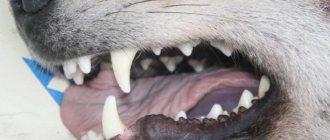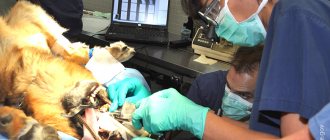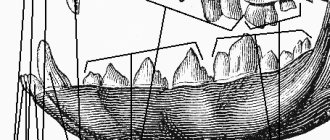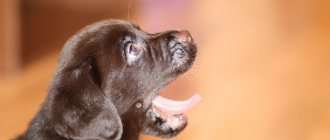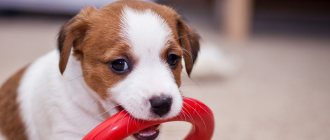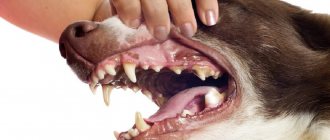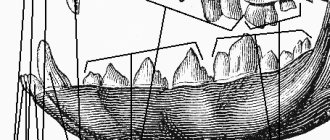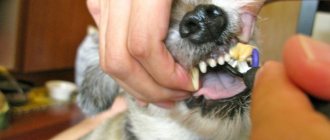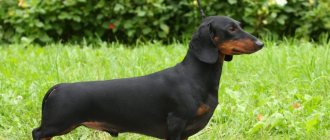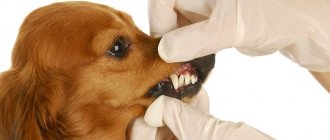The structure of the dog’s oral cavity plays a big role. The general condition of the animal and its life as a whole often depend on how it is developed. However, dog owners often do not know about this and have no idea how many teeth a dog has, and that they must certainly monitor the health of their pet’s mouth and carry out certain hygiene procedures.
We have developed this detailed article together with professional dog handlers and breeders for you so that you can properly care for your beloved pet. Therefore, it is worth reading for everyone who has a dog at home. And it doesn’t matter at all what breed.
Dog dental formula
The dog's permanent teeth have designations made up of numbers and various letters of the Latin alphabet.
The dog’s dental formula in the diagram looks like this:
- 2M 4P 1C 3I 3I 1C 4P 2M.
- 3M 4P 1C 3I 3I 1C 4P 3M.
Letters of the Latin alphabet - names of the type of clove:
- I – incisors.
- M – molars.
- C – fangs.
- P – premolars.
A dental formula is a diagram where a certain number can indicate the number of components, and a letter can indicate their type. The diagram is recorded in the order in which the dog's teeth are in the mouth. This method of recording dental patterns has been used for many years and during this time it has shown its effectiveness.
detailed instructions
If your pet’s teeth are being brushed for the first time, then you must first give him the opportunity to get used to the brush: give it to the Chihuahua, so that the dog can be convinced that this object is not scary and does not pose a danger to him.
Next, you need to let the dog lick some of the paste, which will also convince him that nothing bad is happening.
Chihuahua's teeth need to be brushed like this::
- Apply the amount of paste specified in the instructions to a soft brush.
- Part the dog's lips and begin cleaning its teeth.
- In this case, you should not press the brush too hard or move it horizontally. You need to brush your pet's teeth in a circular or sweeping motion, directing the brush from bottom to top in the direction of tooth growth.
- Further, if necessary according to the instructions, the toothpaste is washed off with warm, but not hot water.
- After cleaning your teeth, experts recommend using a gum massage brush.
It is best to accustom your pet to brushing its teeth from an early age, then the sight of a toothbrush will not cause panic in an older dog, which will significantly facilitate the brushing process and make it more enjoyable.
How many teeth does a dog have?
Structure
An adult dog has exactly 42 teeth in its mouth. However, sometimes there is a shortage or excess of chewing devices. The animal's carnivorous denticles are always normal. All predators known to us have them. These are quite strong devices that can easily grind any bones. They grow in dogs in the first year, gradually changing from acute milky ones to full-fledged permanent ones.
How many teeth does an adult dog have?
A dog that is over seven months old should not have temporary teeth in its mouth. A large dog has forty-two teeth: twenty on the upper jaw and another 22 on the lower jaw. You can even find out its exact age by looking at an animal's chewing devices. To accurately determine age, it is important to take into account the level of sharpening of the incisors:
- The front ones wear down a little at the bottom after a year and a half.
- Lower middle from below to - 2.5 years.
- Front on top - by 3.5 years.
- Average on top - by about 4.5 years.
- The last ones from the bottom - by 5.5 years.
- The last ones on top - by the age of six.
Puppy's milk teeth
Dogs are born into this world without teeth. At the beginning of the third week, their temporary teeth begin to erupt:
- Incisors grow at 4-5 weeks.
- The canines continue to grow for 3-5 weeks.
- Premolars in dogs grow in about 5-6 weeks.
Animals that are already two months old should have exactly 28 teeth in their mouth - fourteen on each jaw. When an animal is teething, it is important to understand how you can help her. It is necessary to buy toys that your pet can scratch its gums on. This way he won’t be able to spoil various things.
If the number of teeth is not normal
Not all animals, unfortunately, have the correct dental formula. Today, it is increasingly possible to encounter various deviations in the number of chewing devices, downwards or upwards. The exception is certain breed standards that arose directly during selection. Professionals specially raised them with such a dental apparatus and the number of chewing devices for specific purposes.
Reasons for possible abnormalities in dogs:
- Genetic inheritance.
- Personal characteristics of development and growth.
- Wrong diet.
- Deficiency of vitamin D, calcium and other elements.
- Injuries, illnesses and various metabolic disorders.
Types of teeth
Dogs have three types of teeth, each with a specific function.
Fangs
Fangs are fairly long teeth. They are located directly between the incisors and premolar teeth. There are four of them, two on top and bottom, one on the right and on the left.
Permanent teeth
After the canines come the premolars. There are four of them on all sides. They are found on all jaws. Behind them the molars continue. There are molars on all sides.
Incisors
There should be six of these chewing devices on all the dog’s jaws. To the right and left of the special vertical straight line, which divides the pet’s entire jaw into two halves, there are hooks. Next come the middle ones, and then the edges.
Appearance scheme
Chart of molars in dogs
Change in the appearance of molars:
- First, the animal loses its temporary incisors - the puppy is three to four months old.
- At six to seven months, the dog's fangs are replaced.
- With the fangs, all premolars fall out.
By nine months the process ends, and at the same time the dog’s radical bone formations appear.
Note. Representatives of small breeds are one to two months behind in terms of changes in the chewing apparatus.
Puppy's milk teeth
Small dogs live without teeth until the third or fourth week. Afterwards the temporary teeth erupt.
The appearance of milk teeth looks like this:
- Lower jaw: almost a mirror image of the upper.
- The dog's upper jaw: six incisors, two canines, six premolars - a total of fourteen teeth.
Caring for permanent teeth of an adult dog
A deficiency of certain microelements in food, as well as poor heredity, is a sure path to various diseases in your dog. Various diseases and the reluctance of animal owners to take care of the hygiene of their pet’s mouth predispose to all this.
The care procedure is necessary every day. If the dog is stubborn, you can do this twice a week. To do this, use a brush and paste. The procedure should be taught step by step: let the purchased paste smell, lift your lip, run your finger over the teeth. When the dog calms down and understands that there is no danger, you can calmly clean the outside.
It is best to carry out this cleaning after the dog is tired after a walk. In addition, chewing sticks clean the mouth.
Note. When cleaning the chewing apparatus, you need to talk to the animal to calm it down.
Prevention of dental diseases
Regular preventative measures will protect your Chihuahua's teeth from diseases and other problems. These include:
- Daily examination of the dog's oral cavity;
- Weekly brushing of teeth and massage of gums;
- Enrichment of food with vitamins and minerals;
- Controlling the process of changing teeth;
- Passing a scheduled examination every six months at a veterinary clinic.
The formation of the dental system and bite in a Chihuahua is a complex process. This is due to the miniature size of the dog. The owner needs to monitor how the teeth change. Follow the rules for caring for them. This is the only way to preserve the integrity and health of your pet’s dental system.
Bite in dogs
The bite is the position of the dog's jaws relative to each other.
Types of bite:
- Scissor-shaped. This is the correct type of bite. It is common for many dog breeds, since the lower jaw normally fits under the upper jaw. This bite is considered physiologically correct. It gives the dog the opportunity not only to chew food normally without injury, but also to make a fairly strong grip.
- Snack . In this case, the dog’s lower jaw protrudes forward, exposing the incisors and fangs. Can be considered the norm only in certain dog breeds with a short muzzle.
- Pincer-shaped . This type of bite is the norm for many dog breeds. In this bite, the lower and upper incisors are connected to each other, so the dog’s teeth become crowded together much more quickly.
- Underbite . This is a situation when the dog’s lower incisors and upper incisors are not connected at all, and the canines are tightly pressed to each other.
Cleaning Methods
Special toys or treats
With the help of such devices you can clean your pet’s teeth quite well..
Before giving a puppy or adult Chihuahua such a toy or treat, you need to make sure that the item does not have sharp edges or corners that could injure the dog, and that the device itself is soft enough and will not harm the teeth.
Toothbrush for dogs
It is not difficult to choose a brush and toothpaste suitable for your Chihuahua: pet stores have a large selection of such devices.
In this case, you need to take into account not only the size of the brush, but also the stiffness of its bristles: for a Chihuahua it should be minimal.
When choosing toothpaste for your pet at a pet store, you need to give preference to one that does not have to be washed off . You should not brush your Chihuahua's teeth at home with anything other than toothpaste intended for dogs.
Ultrasound
This method is suitable for cleaning teeth if plaque has already turned into tartar and it is impossible to remove it with a brush and paste.
To carry out this procedure, you should contact a veterinary clinic.
CAREFULLY!
You should not try to remove tartar yourself, using unsuitable hard or, especially, sharp objects, as you can easily break your dog’s tooth or injure his gums.
Problems in dogs
Different breeds of dogs can have quite a few dental problems, but two of the most common ones are worth highlighting.
Malocclusion
This problem in an adult dog is difficult to correct, so it is advisable to take care of this from the pet’s childhood.
It is important that his diet is complete. It is necessary to look at the various marks on the packages. The food should be intended for puppies, as it contains a normal amount of microelements and vitamins. When choosing food, it is important to focus on its overall quality.
If you feed puppies natural food, do not forget about purchasing a complex of minerals and vitamins. Your veterinarian will help you choose the correct dosage and required composition.
This problem is fraught with diseases of internal organs, which is why it is so important to contact a veterinarian in a timely manner. He will assess the condition of the animal’s mouth and make recommendations. If necessary, a brace system can be installed.
Note. The time to contact a veterinarian in this case is limited - five to twelve months.
Gum inflammation
Gingivitis leads to loss of the masticatory apparatus, as well as blood poisoning. The animal wants to eat, but cannot do so due to severe pain. Constantly whines - there are ulcers with pus in the mouth, saliva flows heavily. The main reasons for the appearance of gingivitis are a change in teeth, various allergies, a deficiency of some vitamins, or tartar.
Do I need to clean it and how often should I do it?
Most dogs can simply chew on special treats or toys to clean their teeth, and Chihuahuas can be given these too . But you shouldn’t count on the fact that with the help of such devices it will be possible to completely rid your dog of dental plaque.
Additionally, many of these toys and treats are quite hard and can damage your pet's teeth.
NOTE!
One of the breed characteristics of Chihuahuas is the softness and fragility of the bones, due to which the fontanel on their head may not heal until the end of their lives.
For the same reason, Chihuahua teeth are very susceptible to premature wear, as well as caries, which mainly affects the lower part of the tooth.
Chihuahuas require special dental cleaning . This procedure is recommended to be carried out twice a week, but if the need arises, it can be done more often.
Expert opinion
Tolkachev Andrey Mikhailovich
veterinarian
“Due to their breed characteristics, Chihuahuas are very susceptible to dental diseases and injuries. Caries, breakage and fracture of teeth are not uncommon for them. In order to avoid these problems, you need to regularly brush your dog's teeth using a special brush. During the procedure, it is unacceptable to press or rub your teeth too hard, as this can lead to damage. If time is lost and the plaque has hardened so much that it can no longer be removed with a brush, then you should contact the clinic to remove it using a gentle method.”
When to contact a veterinarian
Frequent dog diseases that, unfortunately, cannot be dealt with on your own:
- Stomatitis is a problem with the oral mucosa.
- Caries is a disease of tooth enamel.
- Periodontitis is a disease of the tissues directly around the tooth.
- Tartar is the appearance of hard plaque on the teeth.
- Pulpitis is the presence of a large amount of pus directly in the root canal.
The dog's teeth break regularly. This happens due to a deficiency of beneficial microelements or vitamins in the diet, injury or severe pressure.
Gingivitis is inflammation of the gums. This disease causes many problems - the dog constantly whines and is unable to eat.
Another problem that requires veterinary help is malocclusion. It may occur due to abnormal development of the denticles.
Deviations from the norm in development
Most deviations in the development of Chihuahua puppies are associated with improper care and maintenance and genetic characteristics of the representatives of the breed. Underfeeding, as well as overfeeding pets, negatively affects their physical condition. Deviations from the standard are considered serious deficiencies. They could be:
- narrow, too wide or flat skull;
- weak stop;
- small or bulging eyes;
- long muzzle;
- drooping ears;
- barrel-shaped or too small chest;
- short neck;
- indirect line of the back;
- elongated body;
- short legs and their narrow set;
- stubby or curled tail;
- jaw displacement, extra teeth.
If there are significant deviations from the standard, you should visit a veterinary clinic, find out the reasons and proceed to treatment, if possible. Most often, developmental disorders occur due to congenital pathologies, digestive disorders, infection with worms, improper care and an unbalanced feeding diet. It happens that babies lag behind in development because they are offended by stronger puppies, pushing them away from their mother’s breast.
Disqualifying defects include:
- too light build or long body;
- cryptorchidism in males;
- weight exceeding 3 kg;
- bald spots on the body;
- docked tail and ears.
Dog's age by teeth
According to many experts, a dog’s age can be determined directly by its teeth:
- By the age of 1.5 years, the lower front incisors of dogs of different breeds become dull.
- By 2.5, the middle incisors from below begin to wear down.
- At 3.5, the upper front incisors become blunt.
- At 4.5, the top middle teeth become blunt.
- At 5.5 years old, the last lower incisors become blunt.
- At 6.5 years old, the last upper incisors are ground down.
- By 8, the fangs become dull.
- By age 10, a dog’s front incisors become oval-shaped, and by age 12, they fall out.
- Before the age of sixteen, any dog loses all its other teeth.
Note. Depending on the conditions in which the dog is kept, the abrasion and loss of teeth may occur faster or slower.
What factors influence the growth and development of puppies?
Several factors influence physical and psychological development and the rate at which a dog gains weight:
- Hereditary predisposition - when purchasing a puppy, you need to carefully study its pedigree. Pathology or developmental retardation may appear even after several generations. Genetics dictates what size an adult Chihuahua will be, how quickly it grows, when its first heat occurs, when its teeth erupt or change.
- Regime and conditions of detention - the development of dogs is affected by lighting, temperature and humidity in the room, length of day and night, climate, weather.
- Litter size – the more brothers and sisters a Chihuahua has, the smaller they are at birth. Further, puppies may lag behind in development if they do not have enough breast milk or develop normally when they have enough nutrition and physical activity.
- Feeding and care - a correct, nutritious diet, a cozy, comfortable environment, combined with reasonable physical activity - have a positive effect on the development of the Chihuahua.
